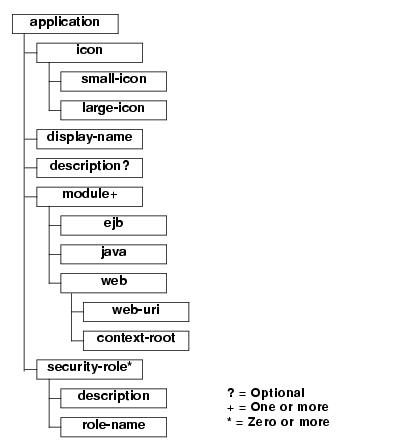application.xml
application.xml Deployment Descriptor Elements
The following sections describe the application.xml file.
The application.xml file is the deployment descriptor for Enterprise Application Archives. The file is located in the META-INF subdirectory of the application archive. It must begin with the following DOCTYPE declaration:
<!DOCTYPE application PUBLIC "-//Sun Microsystems,
Inc.//DTD J2EE Application 1.2//EN"
"http://java.sun.com/j2ee/dtds/application_1_2.dtd">
The following diagram summarizes the structure of the application.xml deployment descriptor.

The following sections describe each of the elements that can appear in the file.
application
application is the root element of the application deployment descriptor. The elements within the application element are described in the following sections.
icon
The icon element specifies the locations of small and large images that represent the application in a GUI tool. This element is not currently used by WebLogic Server.
small-icon
Optional. Specifies the location for a small (16x16 pixel) .gif or .jpg image used to represent the application in a GUI tool. Currently, this is not used by WebLogic Server.
large-icon
Optional. Specifies the location for a large (32x32 pixel) .gif or .jpg image used to represent the application in a GUI tool. Currently, this element is not used by WebLogic Server.
display-name
Optional. The display-name element specifies the application display name, a short name that is intended to be displayed by GUI tools.
description
The optional description element provides descriptive text about the application.
module
The application.xml deployment descriptor contains one module element for each module in the Enterprise Archive file. Each module element contains an ejb, java, or web element that indicates the module type and location of the module within the application. An optional alt-dd element specifies an optional URI to the post-assembly version of the deployment descriptor.
ejb
Defines an EJB module in the application file. Contains the path to an EJB JAR file in the application.
Example:
<ejb>petStore_EJB.jar</ejb>
java
Defines a client application module in the application file.
Example:
<java>client_app.jar</java>
web
Defines a Web application module in the application file. The web element contains a web-uri element and a context-root element.
- web-uri
Defines the location of a Web module in the application file. This is the name of the .war file.
- context-root
Required. Specifies a context root for the Web application.
Example:
<web>
<web-uri>petStore.war</web-uri>
<context-root>estore</context-root>
</web>
security-role
The security-role element contains the definition of a security role which is global to the application. Each security-role element contains an optional description element, and a role-name element.
description
Optional. Text description of the security role.
role-name
Required. Defines the name of a security role or principal that is used for authorization within the application. Roles are mapped to WebLogic Server users or groups in the application.xml deployment descriptor.
Example:
<security-role>
<description>the gold customer role</description>
<role-name>gold_customer</role-name>
</security-role>
<security-role>
<description>the customer role</description>
<role-name>customer</role-name>
</security-role>
application.xml的更多相关文章
- Jsoup问题---获取http协议请求失败 org.jsoup.UnsupportedMimeTypeException: Unhandled content type. Must be text/*, application/xml, or application/xhtml+xml.
Jsoup问题---获取http协议请求失败 1.问题:用Jsoup在获取一些网站的数据时,起初获取很顺利,但是在访问某浪的数据是Jsoup报错,应该是请求头里面的请求类型(ContextType)不 ...
- Jsoup获取部分页面数据失败 org.jsoup.UnsupportedMimeTypeException: Unhandled content type. Must be text/*, application/xml, or application/xhtml+xml.
用Jsoup在获取一些网站的数据时,起初获取很顺利,但是在访问某浪的数据是Jsoup报错,应该是请求头里面的请求类型(ContextType)不符合要求. 请求代码如下: private static ...
- application/xml和text/xml的区别
XML有两个MIME类型,application/xml和text/xml,它们之间的区别是: text/xml忽略xml文件头中的关于编码的设定(<?xml version="1.0 ...
- 有关spring-servlet.xml 和 application.xml的配置信息讲解(这两个配置信息的区别在哪里)
在使用springmvc时需要配置得信息有两个,一个是spring-servlet.xml和applcation.xml: 首先两个文件的的存放位置就有一点的不同(见下图),application.x ...
- Springmvc配置文件application.xml 和 spring-servlet.xml
文章来源:http://blog.csdn.net/tengdazhang770960436/article/details/48395885 1.SpringMVC 的配置分为两部分 applica ...
- application/xml 和 text/xml的区别
application/xml and text/xml的区别 经常看到有关xml时提到"application/xml" 和 "text/xml"两种类型, ...
- ssh2的application.xml配置文件配置详解
ssh2的application.xml配置文件配置详解 1.导入其他的配置文件.在ssh项目中可以导入其他的配置文件,导入的格式为: <import resource="clas ...
- 在properties.xml中定义变量,在application.xml中取值问题
如果为application.xml中的变量赋默认值,同时又在properties.xml中变量赋值,而加载后是取不到properties.xml中的值的问题. 解决这个问题需要加上黑体部分配置: & ...
- Spring------约束导入和application.xml的引入方式
1.spring约束的导入 2.SSH常用约束 3.application.xml的引入方式 <1.通过ClassPathXmlApplicationContext引入配置文件applicati ...
- webservice接口问题:Payload: No message body writer has been found for class domain, ContentType: application/xml
当在使用cxf-rs的webservice的时候,有时候在传输数据,会发生这种错误 错误代码: Response-Code: 500 Content-Type: text/plain Headers: ...
随机推荐
- 省队集训 Day3 杨北大
[题目大意] 给出平面上$n$个点$(x_i, y_i)$,请选择一个不在这$n$个点之内的点$(X, Y)$,定义$(X, Y)$的价值为往上下左右四个方向射出去直线,经过$n$个点中的数量的最小值 ...
- Response.Redirect在新窗口打开(转载)
Response.Rederect在默认情况下是在本页跳转,所以除了在js中用window.open或是给A标签添加target属性之外,在后台似乎不能来打开新的页面,其实不然,通过设置form的ta ...
- python学习笔记(九)之字符串
定义字符串 >>> mystring = 'Hello Python' >>> name = str('Mountain') >>> mystri ...
- bzoj 1202 并查集
首先我们知道若干区间和信息,判断给出信息是否合法,可以用并查集维护,我们用dis[x]表示x到father[x]的距离为多少,即区间father[x]到x的长度,这样我们可以在路径压缩的时候维护dis ...
- Chrome 浏览器 autocomplete off无效
在表单填写时突然发现autocomplete 失效了 网上搜索后得出大概意思是在某些情况下确实无效[捂脸] 解决方案 大致原因是浏览器默认为type为password的input标签自动填充密码 这样 ...
- Fiddler抓取HTTPS协议
HTTPS协议握手过程: 1,客户端明文请求,把自己支持的非对称加密算法(用于使用CA证书公钥加密计算生成协商密钥的随机数per_master).对称加密算法(用于以后使用协商密钥加密传输内容).验证 ...
- perl输出重定向
use utf8; open A, ">&STDOUT"; open STDOUT, ">AA.txt"; print STDOUT 'AB ...
- Linux后台研发面试题
本系列给出了在复习过程中一些C++后台相关面试题,回答内容按照笔者的知识点掌握,故有些问题回答较为简略 1.信号的生命周期 一个完整的信号生命周期可以用四个事件刻画:1)信号诞生:2)信号在进程中注册 ...
- Linux 入门记录:十一、Linux 用户基础
一.用户.组 1. 用户 当我们使用 Linux 时,需要以一个用户的身份登录,一个进程也需要以一个用户的身份运行.用户限制使用者或进程可以使用或不可以使用哪些资源. 2. 组 组用来方便地管理用户. ...
- 学习 Linux,101: 自定义或编写简单脚本【转】
转自:http://www.ibm.com/developerworks/cn/linux/l-lpic1-105-2/index.html 学习如何使用标准的 shell 语法.循环和控制结构,以及 ...
